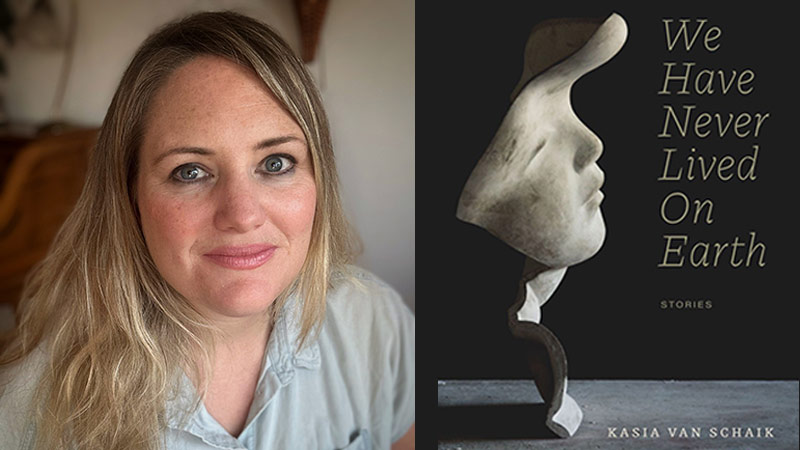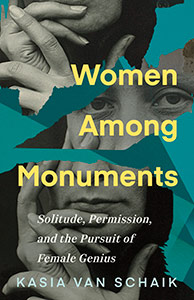2023 Giller nominee Dr. Kasia Van Schaik on process, perfectionism, and the pursuit of female genius
Author: Kayla Cormier
Posted on Nov 6, 2024
Category: UNB Saint John , UNB Fredericton

Dr. Kasia Juno Van Schaik, a South African-Canadian writer and literary critic, recently joined the University of New Brunswick (UNB) English Department as an assistant professor in English and creative writing.
Van Schaik holds a PhD in literature from McGill University. She is the author of We Have Never Lived on Earth, which was nominated in 2023 for The Giller Prize - Canada’s most prestigious literary award - the 2022 Concordia University First Book Prize, and Quill & Quire’s ReLit Prize for short fiction. Poems from her chapbook, Sea Burial Laws According to Country, received McGill’s Mona Adilman Prize in Poetry related to ecological concerns.
Fawn Parker, a PhD candidate in creative writing at UNB, called Van Schaik “a genius”—a title with layered meaning in the context of Van Schaik’s forthcoming book of cultural criticism and memoir.
Van Schaik was kind enough to share her thoughts on her writing process, perfectionism, the pursuit of female genius, and an upcoming project that pays tribute to her literary foremothers of the 20th century.
How has the transition been to New Brunswick and to UNB?
I’ve been getting to know my new colleagues here in the English Department and they’re just fantastic. Not all transitions allow you to move into a built-in community of scholars, but I have that here.
UNB has one of the only two creative writing doctoral programs in Canada, so the graduate students are incredible. At the undergrad level as well, the students are happy to be here and eager to learn and be creative.
Every class is a new adventure, because students have varied backgrounds and so many contributions to bring to class discussions. They bring different points of view and writing styles, so it’s exciting. Every day is different.
It’s also been very busy. I’ve had a few chances to go for walks and bike rides around the city, and I just recently visited the Bay of Fundy, which was lovely.
How did your path lead you here? Have you always known you wanted to be a writer?
I was very interested in storytelling as a child. I would make comic strips and write poems and stories, and then as a teenager I became interested in song writing. For some years I worked as a musician, writing songs and poems and fiction alongside that. When I went to university, I became more serious about writing.
I’m a very slow writer [she laughs], so that’s something I grapple with. I think perfectionism can be quite harmful – there’s a lot of self-editing and self-doubt that comes with the process.
Does writing creatively and writing academically differ for you? Is it a different process?
My approach to creative work and scholarship is quite similar. If I’m writing an essay, I must find something about the subject that captures me. Maybe it’s a line in a work, or an odd detail, like a continuity error in a film. That’s how I find my way in. Then, once I’m in, I can think more critically and more capaciously about the larger piece under study.
And with creative work as well, there has to be something that thrills, delights, or disturbs me. It often comes from a specific detail in an image or memory—but whatever the catalyst, it must be something I want to push on a bit more. Roland Barthes calls this detail the “punctum”—that which pricks or pierces you. It's a curious feeling, the sensation that ‘yeah, I want to keep pushing on this, even if it pricks me.’
It's also interesting how different the writing process can be from writer to writer. For example, I’m currently co-editing a book of academic and creative essays called Shelter in Text. My collaborator, Dr. Myra Bloom, and I work on Zoom and google Docs together.
She’ll be writing away, words just appearing miraculously on our shared page, and I have to think for five minutes before I produce a sentence. We laugh about it. It’s equal collaboration in the end, but it’s fascinating to see how writers have very different ways (and speeds) of producing scholarship.
What are some of those ideas or themes that you find yourself wanting to explore?
I love that you asked this question because I do an exercise with my students to get them thinking about exactly this—those preoccupations and thoughts they carry around with them, that they keep returning to in their everyday lives, because those are usually the things we return to in our writing.
Sometimes your preoccupation or theme is not always clear when you start writing a story. I never start writing thinking, ‘OK, I’m going to write a story on the theme of loss.’
But when I look back on the prose I’ve written or the essays I’ve published, there are some very definite themes that arise. I’m very interested in the idea of the good life—the expectation of individual wealth, social success, a nuclear family, a picket fence.
I believe this ideal can be quite harmful for many of us because it’s predicated upon a fantasy and is never truly graspable. My stories are often about characters aspiring to attain more conventional forms of happiness, and then struggling to re-organize their lives when this doesn’t quite work out.
I’m also interested in questions of girlhood—particularly the pain of girlhood, of discovering that you have been socialized and constrained in dangerous ways. I’m really interested in that cusp between girlhood and adulthood, and the ways in which moments of trauma or testing during this time can radically shape one’s life.
I’m preoccupied with exploring ecological perspectives as well. Some people have described my short story collection as eco-feminist, which I think captures it quite well. My poetry often explores animal-human encounters and the care between, or across, species.
Let’s talk about form. Sea Burial Laws According to Country is described as both a poetry collection and a chapbook; and We Have Never Lived on Earth as a short story collection that leans into novel territory. Can you talk about this?
I read a lot of authors who are playing within the margins of form—crossing the poetry and prose divide, which, in some ways is an artificial divide, I think.
I often move between prose and poetry. Something might start out as a poem and then will turn into a short story.
I taught a class once called ‘Promiscuous Forms: Writing Across Genres.’ In it we probed the boundaries between genres of prose, poetry and memoir and examined the forms that arise from blurring and merging these genres.
My book is also a bit of a cross-genre beast: you could call it a linked story collection or a novel-in-stories. The stories can be read as standalone, sort of discrete moments in time, but when read together can link up to create a longer narrative journey. I think life can often feel like that as well.
What are you working on now? I’d love to hear more about Women Among Monuments. Is it a memoir?

The full title is Women Among Monuments: Solitude, Permission, and the Pursuit of Female Genius. It’s part memoir, part literary analysis, part cultural criticism. The book comes out with Dundurn Press in 2025.
I chose to thread stories from my own life throughout the book because I think cultural criticism is so much more compelling to read about when driven by a personal narrative.
In some ways I find writing nonfiction more difficult than writing fiction. Sometimes I wish I could just invent a person or encounter to move the story along, but I have to stick to the facts (laughs).
The book itself is sort of a modern follow up of Virginia Woolf’s very famous and wonderful long essay A Room of One’s Own, which looks at the conditions needed for women to make art and to pursue an intellectual life.
Women Among Monuments questions what those conditions are in the present day.
Many of the questions in Woolf’s text remain perennial and urgent. She concludes her essay with the instructions that a woman must have a room of her own and “the habit of freedom and the courage to write exactly what she thinks.”
I’m really interested in the second instruction here, this habit of freedom.
Of course, space and money are deciding factors when creating art, but there’s also the question of self-worth, self-doubt, and permission, especially for women.
Permission to claim that room and the time spent in it. And there’s also the question of female solitude, which can often be perceived as socially threatening. You know, a woman alone with her books.
Women Among Monuments examines how forms of female genius differ from the idea of the solitary male genius and interrogates the concept of genius itself. It also seeks to make space for under-recognized and under-represented forms of genius amidst the conventional monuments of art and literary history.
Throughout the book I move through different female artists and writers, largely 20th-century women because that’s my expertise.
Women like Gertrude Stein, Toni Morrison, Leslie Marmon Silko, Bernadette Mayer, Jamaica Kincaid and Georgia O'Keeffe. I examine their biographies, practices and work, and then I bring in my own experiences with ambition, frustration, and my attempts to make a habit of freedom; the search for a mental and physical space in which to create.
The last chapter, which I’m writing now, is about the artist’s city amidst rampant gentrification and inflation.
It asks, ‘where and how does creativity survive?’
How can poetry survive in late-capitalism when it feels like everything is narrowing: community spaces, public free space, free time. I’m looking specifically at Montreal, historically an artist’s city, where now artists and poets are being pushed to the margins.
What’s next for you?
I hope to slow down a bit and get to know some of Fredericton’s artists and writers.
I moved to New Brunswick from Montreal, where I lived in a one-bedroom apartment on the fourth floor. I now have a yard with beautiful trees for the first time, and I haven’t had the chance to really enjoy it yet, so I hope to do that. I’m grateful to be here.
